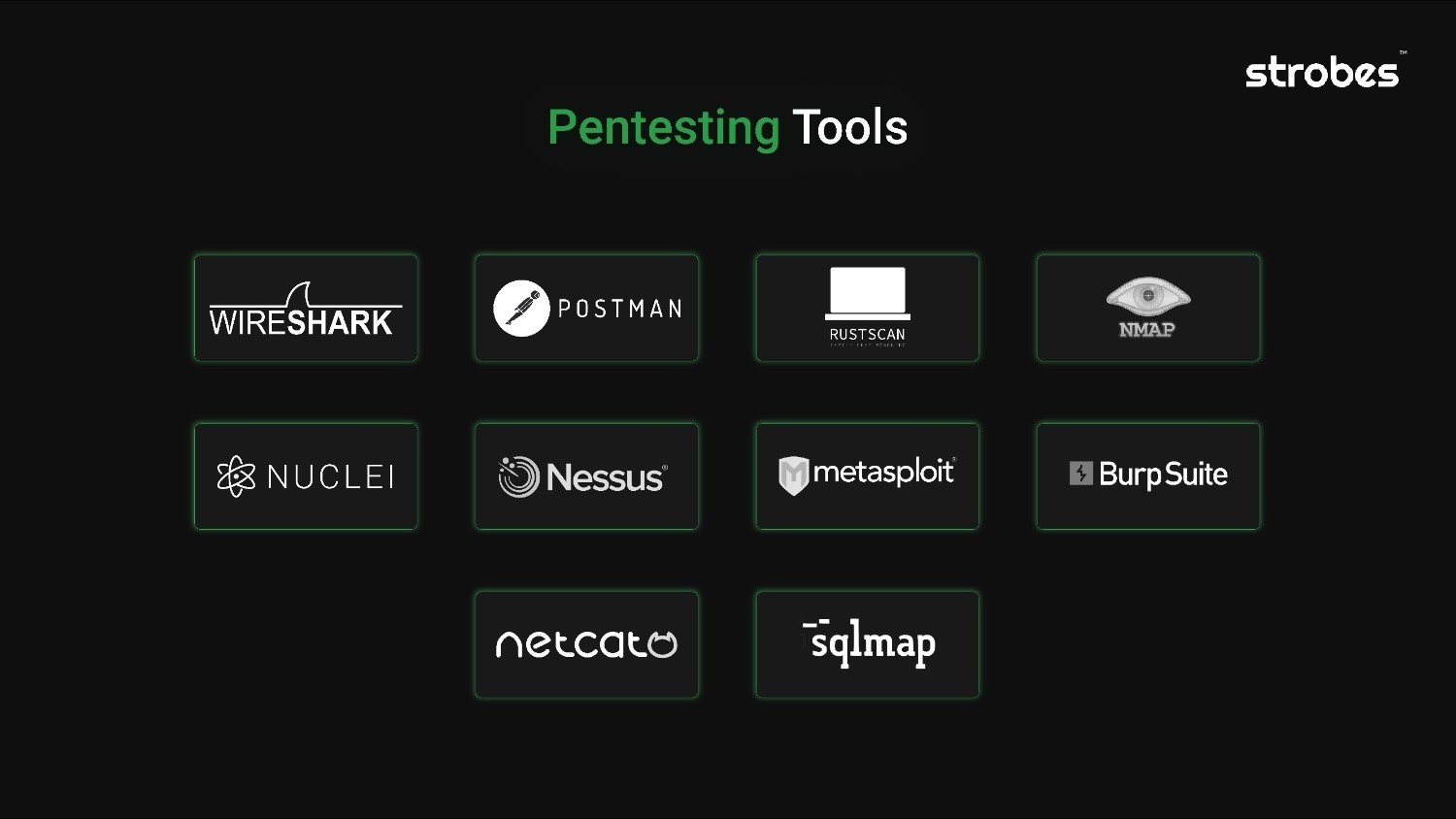If your website handles any kind of user data, chances are it’s being watched. And not just by customers. Hackers, too. That’s why web application penetration testing tools is no longer optional. It’s how you think like an attacker and find weak spots before someone else does. But here’s the deal, the tools you use make or break the test.
So in this post, we’ll break down:
- What pentesting really is
- The key tools used at each step
- When to use what
- And how to build the ultimate toolkit
Let’s roll.
What’s Web application Penetration Testing?
Imagine giving a hacker permission to break into your website. Only this hacker is on your side. Web application penetration testing (or “web app pentesting”) is a process where security pros mimic real-world attacks to:
- Uncover security flaws in your web app
- See how deep they can go
- Help you fix issues before they get exploited
This isn’t just running a scanner. It’s strategic. It’s manual. It’s deep. Pentesting follows a flow and each phase needs a different kind of tool.
Phases of Penetration Testing and Corresponding Tools
The following table summarises the typical phases of web application penetration testing and the corresponding tool categories involved:
| Phase | Description | Relevant Tool Categories |
|---|---|---|
| Planning and Reconnaissance | Defining the scope of the test and gathering information about the target application and its infrastructure. | Scanning & Reconnaissance |
| Scanning and Enumeration | Actively interacting with the target application to discover open ports, services, and potential vulnerabilities. | Scanning & Reconnaissance, Vulnerability Scanning |
| Analysis of Security Weaknesses | Reviewing the findings from the scanning phase to identify exploitable vulnerabilities. | Vulnerability Scanning, Packet Analysis & Sniffing |
| Exploitation | Actively testing identified vulnerabilities to assess their impact. | Exploitation & Enumeration, Web Application Testing, API Testing |
| Post-Exploitation | Activities carried out after gaining access, such as data exfiltration and maintaining persistence. | Exploitation & Enumeration, Mobile Pentesting Tools, Active Directory Enumeration Tools, Cloud Pentesting Tools |
| Reporting and Recommendations | Documenting the findings, the methods used, and providing recommendations for remediation. | All categories as sources of findings |
| Remediation and Re-Testing | Addressing the identified vulnerabilities and conducting re-testing to verify their resolution. | All categories for verification |
Trusted by leading enterprises like, GHX, Zoho, Darwinbox, Tricenties, and SHL
Strobes helped organizations continuously manage threats, reduce vulnerabilities, and stay compliant, powered by AI-driven security expertise.
Curious about the real cost of pentesting? Try our free PTaaS pricing calculator to get an instant estimate tailored to your needs.
The Web application Penetration Testing Tools That Keep Hackers Out
Cyberattacks don’t happen randomly. Hackers follow a process; gathering intel, finding weak spots, and exploiting them. Web app pentesting works the same way, but for defense. Security pros use specific tools at each stage to uncover vulnerabilities before they can be exploited. Here’s the breakdown –
1. Reconnaissance
Before launching an attack, hackers look for publicly available information about a web app. They scan for open ports, exposed files, and weak configurations. Security teams do the same before attackers can.
Key tools:
- Nmap – Scans networks to find live hosts, open ports, and running services.
- Gobuster & FFUF – Bruteforce tools that uncover hidden admin panels, directories, and secret files.
- Whois & Nslookup – Extracts domain ownership details, subdomains, and DNS records.
This phase is like mapping out a building before checking its security flaws. The more you know about an application’s structure, the easier it is to find weak points.
2. Web App Scanners
Now that we know where to look, it’s time to scan the web app itself. Security scanners identify misconfigurations, outdated software, and vulnerable components.
Key tools:
- Burp Suite Professional – The go-to tool for analyzing web traffic, authentication, and data flow.
- OWASP ZAP – A free alternative that scans for common web vulnerabilities like SQL injection and XSS.
- Nikto – A fast scanner that checks for weak headers, outdated versions, and server misconfigurations.
These web application penetration testing tools act as a security X-ray, highlighting flaws that need deeper investigation.
Also Read: Uncovering the Limitations of Vulnerability Scanners
3. Exploiting Vulnerabilities
Not all vulnerabilities are easy to exploit. Some seem dangerous but are hard to use in a real attack. Pentesters don’t just find flaws, they test if they can actually be used to gain access or steal data.
Key tools:
- SQLmap – Automates SQL Injection, where attackers manipulate databases to extract or modify data.
- XSStrike – Finds Cross-Site Scripting (XSS) vulnerabilities, which let attackers inject malicious scripts into web pages.
- NoSQLMap – Targets NoSQL databases like MongoDB, which are common in modern applications.
If a scanner finds a broken lock on a door, these tools test whether someone can actually break in using it.
Also Read: Exploiting limited markup features on web applications
4. API Security
Most web apps rely on APIs to communicate with other services. A weak API can expose customer data, authentication details, and sensitive transactions.
Key tools:
- Postman – Tests API endpoints to see if they can be manipulated or accessed without permission.
- JWT_Tool – Analyzes JSON Web Tokens (JWT), which are commonly used for secure logins. If tokens are weak, attackers can impersonate users.
An API is like a bridge between systems. If it isn’t secured, anyone can walk across it, even those who shouldn’t be there.
Our Solution: Strobes API Security
5. Cloud Security
Many web apps run on cloud platforms like AWS, Azure, and Google Cloud. These platforms add flexibility, but also create new security risks.
Key tools:
- Cloudfox – Helps identify AWS misconfigurations, like publicly exposed S3 storage.
- Pacu – A penetration testing framework for AWS cloud security, simulating real-world cloud attacks.
If a traditional web app is like a secure office building, a cloud-based app is a remote work system. The rules for security change, and pentesting helps catch weak spots.
Our Solution: Cloud Security
Selecting the Right Web application Penetration Testing Tools for the Task

| Tool Name | Category | Key Features | Strengths | Weaknesses |
|---|---|---|---|---|
| Nmap | Scanning & Reconnaissance | Host discovery, port scanning, service detection, OS detection, NSE scripting | Versatile, scriptable, widely used | Can be slow for full scans |
| rustscan | Scanning & Reconnaissance | Fast port scanning, pipes to Nmap | Very fast for initial port discovery | Less comprehensive than Nmap for detailed analysis |
| Wireshark | Packet Analysis & Sniffing | Real-time packet capture, protocol analysis, filtering | Powerful for detailed traffic analysis, GUI-based | Can be overwhelming for beginners, requires understanding of protocols |
| mitmproxy | Packet Analysis & Sniffing | Intercepting proxy, on-the-fly modification, scripting | Excellent for dynamic analysis of HTTP/HTTPS, user-friendly interfaces | Primarily focused on HTTP/HTTPS |
| Nessus Professional | Vulnerability Scanning | Extensive plugin library, comprehensive reporting | Broad vulnerability coverage, user-friendly, commercial support | Commercial tool, can produce false positives |
| Nuclei | Vulnerability Scanning | Template-based, fast, supports multiple protocols | Highly customizable, community-driven templates | Template creation requires understanding of YAML |
| Msfconsole | Exploitation & Enumeration | Modular framework, vast exploit database | Powerful for exploitation and post-exploitation | Can be complex to learn, some exploits may be unreliable |
| Netcat | Exploitation & Enumeration | Basic TCP/UDP connectivity, port scanning, reverse shells | Lightweight, versatile for manual tasks | Limited built-in features compared to specialized tools |
| Burp Suite Professional | Web Application & API Testing | Intercepting proxy, scanner, intruder, repeater | Comprehensive web testing platform, active and passive scanning | Commercial tool |
| Sqlmap | Web Application & API Testing | Automated SQL injection detection and exploitation | Highly effective for SQLi, supports many databases | Primarily focused on SQLi |
| Postman | Web Application & API Testing | API request building, testing, and documentation | User-friendly for API testing, supports automation | Not primarily a security testing tool |
Why do These Web App Pentesting Tools Matter?
A single vulnerability can cost a business millions. Data breaches, ransomware attacks, and account takeovers all start with one weak spot. The good news? Web app pentest tools give defenders the same advantages as attackers. By using the web application penetration testing tool regularly, security teams can find and fix issues before they’re exploited.
Pentesting isn’t just about compliance or checking a box. It’s about staying ahead of real-world threats because hackers won’t wait for a scheduled test.
Why is Traditional Pentesting Outdated?
Traditional pentesting has significant flaws:
- It’s slow – A one-time test takes weeks, and by the time a report is ready, the attack surface has already changed.
- It’s expensive – Hiring ethical hackers on a per-test basis is costly and inefficient.
- It’s incomplete – Many pentests only cover known vulnerabilities and ignore new threats.
What Is PTaaS?
PTaaS stands for Penetration Testing as a Service. But what does that really mean? Old-school pentesting was like hiring a band. They show up once a year, play their set (test your systems), then vanish with a report. You wait. You read. You forget. PTaaS flips that model.
It’s:
- On-demand
- Continuous
- Collaborative
With PTaaS, you get:
- Access to expert ethical hackers anytime: Certified professionals who think like attackers, but work for you.
- Real-time updates on findings: No more waiting days for a PDF. You see issues as they’re found, with risk insights and remediation steps right in your dashboard.
- Integrated workflows: Everything flows into your tools, Slack, Jira, CI/CD, so your team can fix fast without leaving their lane.
- Personalized dashboards: CISOs get high-level summaries. Devs see what’s relevant to them. Compliance teams get exportable reports that actually make audits easier.
- Dynamic reporting: Your reports evolve with the test, complete with severity tags, business impact, and fix instructions.Technical where it counts. Executive-ready when it matters.
Here’s everything you need to know about the penetration testing report.
How PTaaS Makes Web App Security Simpler and Smarter?
At Strobes, our Penetration Testing as a Service (PTaaS) offers a steady, expert-led, and automation-supported way to test your web apps. Here’s what it looks like in practice:
- Ongoing Testing – Not once a year. We test continuously so nothing slips through the cracks.
- Focus on What Matters – We highlight the most important issues first, so your team can fix what actually matters.
- Blend of Tools + People – Automated scans help with speed. Our certified pentesters handle the rest.
- Faster Fixes – Every issue comes with clear impact, steps to reproduce, and how to fix it.
No waiting. No noise. Just testing that keeps up with your app.
How to Build a Bulletproof Web App Security Strategy?
Having the right web application penetration testing tool are important, but organizations also need a structured security strategy to protect their web applications effectively.
1. Combine Automated & Manual Testing
- Use automated scanners like Burp Suite & OWASP ZAP to catch common vulnerabilities.
- Perform manual testing to uncover logic flaws and zero-day vulnerabilities.
2. Follow a Standardized Testing Framework
Adopt industry-approved frameworks like:
- OWASP Testing Guide – Covers critical web vulnerabilities.
- NIST 800-115 – Offers guidelines for structured penetration testing.
- SANS Top 25 – Focuses on high-risk software vulnerabilities.
3. Shift Left with DevSecOps
- Test for vulnerabilities before deployment.
- Integrate security tests in CI/CD pipelines.
- Educate developers on secure coding practices.
4. Move from One-Time Testing to Continuous Security
- Traditional pentesting is a snapshot, PTaaS offers continuous security validation.
- Strobes Risk-Based Vulnerability Management (RBVM) prioritizes high-impact vulnerabilitiesRBVM Datasheet .
How We Do It at Strobes?
At Strobes, we’ve taken everything good about traditional pentesting and removed the pain.
Here’s how it works:
- You create an engagement in our platform — Add in URLs, IPs, business sensitivity, etc.
- You tell us when to start — Today? Next month? We’ve got you.
- Our certified hackers get to work within 48 hours — OSCP, CREST, CRTP, CISSP… we’re not playing around.
- You collaborate in real time — Chat with our testers, track progress, and get updates inside the Strobes dashboard or Slack.
- Findings are delivered in one clean, organized dashboard — Everything’s sorted, deduplicated, and prioritized by risk.
- You fix, we retest twice — And confirm everything’s closed.
Engagement Types? We Cover Them All
1. Web Applications
Testing websites and browser-based platforms for vulnerabilities like XSS, SQL injection, and authentication flaws.
Also Read: Web Application Penetration Testing: Steps & Test Cases
2. Mobile Applications
Security testing of Android and iOS apps to find issues in local storage, API calls, and runtime behavior.
3. APIs (Application Programming Interfaces)
Assessing exposed endpoints for improper authorization, data leakage, injection flaws, and misconfigurations.
4. Cloud Infrastructure
Testing cloud environments (AWS, Azure, GCP) for misconfigurations, access control issues, and exposed services.
5. Network (Internal + External)
- Internal Network – Simulating insider threats to uncover risks within your corporate network.
- External Network – Scanning public-facing assets to find open ports, vulnerable services, and entry points.
6. Red Teaming
A full-scope, stealth attack simulation to test detection and response capabilities, combining multiple attack vectors.
Our Solution: Red Teaming
7. Social Engineering
Testing human vulnerabilities through phishing emails, impersonation, or baiting tactics to assess employee awareness.
We test for real-world stuff. Not just “checkbox security.” And we follow frameworks like OWASP, SANS 25, NIST, and OSSTMM.
With over 100,000+ hours of pentesting experience and 2 million+ vulnerabilities prioritized, we’ve seen it all. And solved it.
Final Thoughts
Web applications are the primary attack vectors for cybercriminals. Without regular penetration testing, businesses risk data breaches, financial loss, and reputational damage.
The solution? A proactive, continuous security approach.
- Use Burp Suite for deep security analysis.
- Leverage SQLmap for database security.
- Deploy Postman for API security validation.
- Adopt Strobes PTaaS for continuous, automated pentesting.
Cyber threats evolve daily, so should your security strategy. Traditional pentesting is no longer enough. Organizations must embrace PTaaS to ensure always-on security. Want to see how Strobes PTaaS can transform your web app security? Schedule a call today!
Related Reads:
- Web Application Penetration Testing: Steps & Test Cases
- Decoding the Penetration Testing Process: A Step-by-Step Guide
- Why Penetration Testing Is Important: Enhancing Security & Reducing Cyber Risks
- How much does a penetration test cost?
- How Strobes Penetration Testing Supports Compliance Audits and Assessments
- Solution: Pentesting as a Service
- Solution: Web Application Pentesting
- Solution: Mobile Application Pentesting









